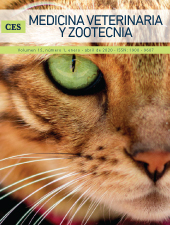Size sexual monomorphism in Barroso-Salmeco cattle from Guatemala
DOI:
https://doi.org/10.21615/cesmvz.15.1.2Keywords:
Rensch’s hypothesis, body weight, creole breed, zoometry, variabilityAbstract
Sexual dimorphism in size (SSD) is a widespread phenomenon in animals. Its causes remain obscure, as well as its allometric relationship with body size (Rensch’s hypothesis). Here, in order to contribute a better description of the Barroso-Salmeco cattle from Guatemala, we analyze SSD in 5 bulls and 49 females aged more than 3 years, using 23 lineal morphostructural traits and body weight. It was detected no SSD, and only cannon thickness appeared different between genders. Results of sexual dimorphism analyses discard male-biased sexual size differences in this breed and they point rather towards a sexual monomorphism.
Downloads
References
Aracena, M. P. (2010). Caracterización fenotípica del bovino Criollo patagónico. Un estudio de caso. Universidad Austral de Chile. Retrieved from http://cybertesis.uach.cl/tesis/uach/2010/faa658c/doc/faa658c.pdf
Bidau, C. J., & Martinez, P. A. (2016). Sexual size dimorphism and Rensch’s rule in Canidae. Biological Journal of the Linnean Society; 119: 816–830.
Camargo, O. (2012). Sexual Dimorphism and deviation en the proportion of sexes in preimplantory embryos. Revista CES Veterinaria y Zootecnia, 7 (1): 100-114. Retrieved from http://www.scielo.org.co/pdf/cmvz/v7n1/v7n1a09.pdf
Chirinos, Z., Contreras, G., Zambrano, S., Molero, E., & Páez, A. (2011). Caracte-rizacion del dimorfismo sexual en ganado criollo limonero mediante medidas corporales. Rev. Fac. Agron. (UCV);28(1): 554–564.
Dale, J., Dunn, P. O., Figuerola, J., Lislevand, T., Székely, T., & Whittingham, L. A. (2007). Sexual selection explains Rensch’s rule of allometry for sexual size di-morphism. Proceedings of the Royal Society B: Biological Sciences; 274(1628): 2971–2979. https://doi.org/10.1098/rspb.2007.1043
Damme, R. Van, Entin, P., Vanhooydonck, B., & Herrel, A. (2008). Causes of sexual dimorphism in performance traits: a comparative approach. Evolutionary Ecology Research; 10: 229–250.
Escobar, C. De, Villalobos, A., & Núñez, J. (2015). Medidas zoométricas del ganado bovino criollo de Panamá. Revista Investigación y Pensamiento Crítico;2(5): 26–33.
Franco-Moreno, R. A., Cruz-Escalona, V. H., Aurioles-Gamboa, D., Vera-Alfaro, P., Salas, J., & Ravela, S. (2015). Variability and sexual dimorphism in skull mor-phometry of California Sea Lions (Zalophus californianus) in Mexico. Mammalian Biology; 80(4): 316–327. https://doi.org/10.1016/j.mambio.2015.04.001
Fuentes-Ascorro, G., Carmona, M. M. A., Pérez, V. E., & Chirinos, Z. (2011). Caracte-rización del dimorfismo sexual en ganado criollo de Oaxaca, mediante mediante medidas corporales. Actas Iberoamericanas de Conservación Animal; 1: 94–96.
Hammer, Ø. (2002). Morphometrics – brief notes. Zurich.
Hammer, Ø., Harper, D. A. T., & Ryan, P. D. (2001). PAST v. 2.17c. Palaeontologia Electronica; 4(1): 1–229.
Hood, S. (2000). Geometric morphometric approaches to the study of sexual size dimorphism in mammals; 11(1): 77–90.
Jáuregui, J., Gutiérrez, C., Cordón, C., & Vásquez, L. (2014). Determinación mor-foestructural del bovino Criollo Barroso Salmeco en Guatemala. Actas Iberoame-ricanas de Conservación Animal; 4: 6–8.
Khalatbari, L. (2018). Availability of prey and natural habitats are related with temporal dynamics in range and habitat suitability for Asiatic Cheetah. Hystrix It. J. Mamm; 29(1): 87–94. https://doi.org/10.4404/hystrix
Melgar, D. R., Solano, A. R., Tewolde, A., Salgado, F., Mujica, C., & Catie, F. (1988). Caracterización fenotípica del ganado Barroso criollo Salmeco: Memorias. In I.-A. I. for C. on Agriculture (Ed.), Conferencia Internacional sobre Sistemas y Estrategias de Mejoramiento Bovino en el Trópico Guatemala (Guatemala) (pp. 131–146). Turrialba, Costa Rica: Inter-American Institute for Cooperation on Agriculture.
Motani, R., Huang, J., Jiang, D. Y., Tintori, A., Rieppel, O., You, H., ... Zhang, R. (2018). Separating sexual dimorphism from other morphological variation in a specimen complex of fossil marine reptiles (Reptilia, Ichthyosauriformes, Chaohusaurus). Scientific Reports; 8(1): 1–14. https://doi.org/10.1038/s41598-018-33302-4
Owens, I. P. F., & Hartley, I. R. (1998). Sexual dimorphism in birds: why are there so many different forms of dimorphism? Proceedings of the Royal Society B: Bio-logical Sciences; 265: 397–407.
Parés-Casanova, P. M. (2013). No ecogeographical trends in body structure for Zebu (Bos indicus). Global Journal of Multidisciplinary and Applied Sciences; 1–2: 37–40.
Parés-Casanova, P. M. (2015). Geometric Morphometrics to the Study of Skull Sexual Dimorphism in a Local Domestic Goat Breed. Journal of Fisheries & Livestock Pro-duction, 03(03). https://doi.org/10.4172/2332-2608.1000141
Porter, V. (1991). Cattle. A Handbook to the Breeds of the World. Ramsbury, Marlbo-rough: Christipopher Helm Ltd.
Rezić, A., Bošković, I., Lubinu, P., Piria, M., & Florijančić, T. (2017). Dimorphism in the Skull Form of Golden Jackals in the western Balkans: a geometric morpho-metric approach. Pakistan Journal of Zoology; 49(3): 8–12.
Salamanca-Carreño, A., & Crosby-Granados, R. A. (2013). Estudio fenotípico del bovino criollo Casanare biotipo Araucano. Análsisi zoométrico. Zootecnia Tropical;31(3): 201–208.
Sastre, H. J., Rodero, E., Rodero, A., Herrera, M., & Peña, F. (2010). Caracteriza-ción etnológica y propuesta del estándar para la raza bovina colombiana Criolla Casanare. Animal Genetic Resources/Ressources Génétiques Animales/Recursos Genéticos Animales; 46: 73–79. https://doi.org/10.1017/s207863361000072x
Serrano-Meneses, M. A., Reyes Hernández, M., Carrillo Muñoz, A., & Rivas, M. (2014). La conducta reproductiva y la evolución del dimorfismo sexual en ta-maño. In R.-A. J. Martínez-Gómez M, Lucio RA (Ed.), Biología del comportamiento: aportaciones desde la fisiología (pp. 285–298). México: Universidad Autónoma de Tlaxcala.
Sharifi, M., Farasat, H., & Vaissi, S. (2012). Sexual size dimorphism in Neurergus kaiseri (Caudata: Salamandridae) in south-western Zagros Mountains, Iran. Am-phibian & Reptile Conservation; 6(4): 1–8.
Székely, T., Freckleton, R. P., & Reynolds, J. D. (2004). Sexual selection explains Rensch’s rule of size dimorphism in shorebirds. PNAS; 101(33): 12224–12227. https://doi.org/www.pnas.org/cgi/doi/10.1073/pnas.0404503101
Downloads
Published
How to Cite
Issue
Section
License
Copyright (c) 2020 CES Medicina Veterinaria y Zootecnia

This work is licensed under a Creative Commons Attribution-ShareAlike 4.0 International License.
| Article metrics | |
|---|---|
| Abstract views | |
| Galley vies | |
| PDF Views | |
| HTML views | |
| Other views | |



